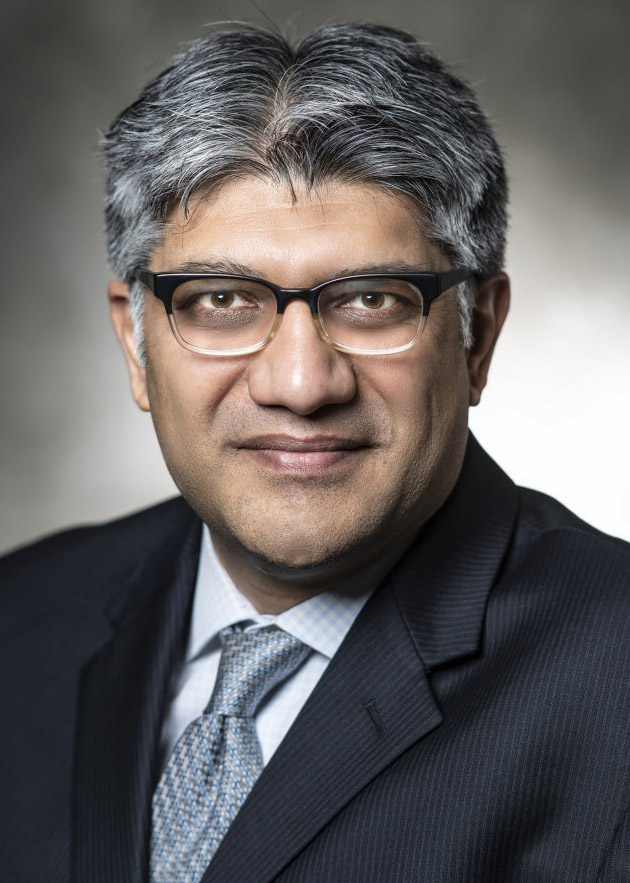Jigar Shah talks about the DOE’s Loan Programs Office

Shah
American Nuclear Society executive director/chief executive officer Craig Piercy interviewed Jigar Shah, the director of the Department of Energy’s Loan Programs Office (LPO), in an ANS members-only online event on December 7. Shah and Piercy discussed the LPO’s role in assisting the U.S. nuclear energy industry both domestically and internationally in working toward the decarbonization of the power sector. The interview served as a follow-up to Shah’s article in Nuclear News, “Deploy, deploy, deploy: Achieving our climate goals requires nuclear this decade” (November 2022, p. 12).
Shah’s expertise: Before becoming LPO director in early 2021, Shah was president of Generate Capital, which he cofounded as an investment and operating platform for sustainable infrastructure, including distributed energy storage, microgrids, fuel cells, electric vehicles, and organic waste management. He also founded SunEdison, which pioneered “pay as you save” financing for solar energy. In addition, he was the founding CEO of the Carbon War Room, a nonprofit organization that helps entrepreneurs address climate change.
Solar and nuclear: Piercy introduced Shah, noting that, as director of the LPO, he is “focused on building a bridge to commercial financing for technologies that are ready to scale the transition to a global clean energy economy. He oversees the planning and execution of literally a 12-figure amount of loan authority within clean energy, transportation, and tribal energy sectors.”
Though his background has been more in solar energy, Shah has become a familiar face to the nuclear energy industry. Piercy asked Shah to talk about the personal journey that led him to nuclear.
Shah replied with a smile, “Well, it all emanates from the sun, right? Because nuclear and solar are both going on there.” He recalled that when he was a boy, his father gave him a book about the different ways of generating electricity and it left an impression on him that all energy technologies are equally viable and capable. However, “the two that struck me as most interesting were nuclear and solar. Nuclear, because I grew up [in Sterling, Ill.] right next to the Byron nuclear power plant, one of the last nuclear power plants to be turned on line. We [in the local high school] always saw how their stuff was really awesome.”
Shah continued, “When I went to college, people were not really building nuclear plants, but they were building solar, so I decided to take solar as my pathway. My appreciation for nuclear power has never been turning negative. I’ve always been positive about nuclear power. Then, when I took the role here at the Loan Programs Office, nuclear is a central part of my responsibilities.”
Financial challenges: Piercy described the “unprecedented interest” in nuclear power in recent years, as reflected by investments and legislation and as associated with concerns regarding climate change and world events. He added, however, that financing costs are a challenge and asked Shah how current financial conditions are affecting his work at the LPO.
Shah replied in part that there was an “enormous effort in 2007–2008, which led to over $150 billion, I think, of nuclear power plants that were being studied by electric utilities around the United States, of which I think something short of $100 billion explored using the Loan Programs Office in that 2009–2010 time frame.”
He added, “Mistakes were made, and, as a result, the Vogtle nuclear plant, which we are funding, came in over budget.” Along the way, he noted, 13,000 union workers and pipefitters have been trained on nuclear, and a robust nuclear supply chain has been invigorated.
There is also a new group of designs that should lead to cost reductions from the larger nuclear power plants, many that had custom-made components. Small modular reactors, he said, “are using, largely, components that are already made for the natural gas industry and other industries. And so you can get lower costs for a lot of those components while maintaining the same level of reliability. So, there’s a lot of positives there.”
Breaking and regaining trust: Shah then pointed out that “fundamentally, the nuclear industry broke trust with its ecosystem. There are a lot of CEOs in the utility space who are saying, ‘Do I really want to bet my chips on building a new nuclear reactor? What reward am I going to get for my shareholders doing that?’
“So now where we are is, Jeff Lyash [president and CEO of the Tennessee Valley Authority] and the good folks at TVA have partnered up with their friends at Ontario Power Group, and they are building GE Hitachi reactors, and those reactors are largely similar to ones that have already been through the nuclear regulatory process. So, we expect it to get through the [Nuclear Regulatory Commission] within a couple years.”
Shah continued, “You now have momentum building again and then the question becomes, ‘When does everyone else jump in? When does the order book of 30 reactors come on line?’ It’s hard. Everyone is inching their way toward trust again, and, frankly, I think we have got the mindset of investors reset.” He referred to the recent announcement that X-energy is becoming a publicly traded company, as well as other encouraging signs, that there is new investor confidence in nuclear energy.
Shah said, “When you think about how that trust-building exercise occurs, it doesn’t happen overnight. People have to meet milestones. People have to make promises. They have to keep promises. And that’s occurring now, which is making me quite bullish on the prospects of nuclear.
“Every model that we’ve done, every single model, on decarbonization includes nuclear. In fact, nuclear is central to every model. Some are at 20 percent, some are at 40 percent, but all of them include nuclear.”
Rallying around a cause: Piercy extended the discussion on industry finances, asking, “I think the incentives are there in the long term, but do you see the financial community really wanting to wait on this until they have a good, firm grasp that this technology is robust, and that it happens all at once?”
Shah answered by referring to the historic ability of the U.S. government to rally around an important cause, citing the example of the attack on Pearl Harbor on December 7, 1941, which led to a massive U.S. military buildup and American involvement in World War II. “But [today] what [nuclear reactor] design are we rallying around? That’s not for the U.S. government to choose. We’ve supported any number of technologies through our [DOE] Advanced Reactor Demonstration Program, all of which are promising designs that we are quite excited about. But the utility sector has to decide which ones they want to do.”
Shah then pointed out that Poland has decided to use U.S. nuclear technology for its planned power plants because it has confidence in American designs. He noted that other countries in Eastern Europe also want new nuclear power plants. He added, “In general, I do believe that American power is projected through our ability to supply solutions to decarbonization around the world.”
Crossing the bridge to bankability: When asked about how the LPO considers ways to “get to the nth-of-a-kind” in advancing U.S. technologies, Shah said that the office has provided loans to the solar and wind industries to help them “get across the bridge to bankability” in order to convince private investors to accept those technologies. He emphasized that the LPO plays a crucial role in new energy technology investments. “When you look at technologies, the commercial debt markets are not really paid to do first-of-a-kind risks or nth-of-a-kind deployments or whatever, until they believe that they are de-risked. And so, when you think about carbon management or nuclear or transmission technologies or sustainable aviation fuels, all of these sectors need us to help them cross the bridge to bankability.”
He continued, “It [generally takes] $100 billion of private sector funding to cross the bridge to bankability. There are steps on that bridge. The first step is first-of-a-kind deployment. The second step is engineering excellence. Then you have the learning curve, where you take incremental new technologies and put them into what is perceived to be old.” Shah mentioned the incremental technological advances that have improved solar panel efficiency, saying that nuclear advances happen similarly—with the technology advancing incrementally while investor confidence builds.
“There will be amazing breakthroughs that occur” in nuclear technologies, he predicted.
LPO improvements: The LPO has implemented management and personnel improvements in recent years as it has continued to evaluate loan risks. “We do have a good process,” Shah said. “We have over $100 billion of loan requests that have come into the office, and we get them through the office systematically. And it is fun, honestly. It’s great to meet the nation’s best entrepreneurs and innovators and help them realize their dreams, which realizes American power.”
Section 1706: The last topic that Piercy asked Shah about was section 1706 of the Inflation Reduction Act, which has provisions for retooling, repurposing, and replacing old energy infrastructure for the installation of new systems, such as the conversion of shut-down coal power plants to new nuclear power plants.
According to Shah, the LPO has been assessing how that section should be implemented. “We’ve worked a lot with the Office of Nuclear Energy,” he said. “We’ve evaluated 600, roughly, coal plants that have been announced for being shut down and tried to take a good cut at which ones would be likely candidates to be converted to nuclear.
“And we’ve been working with all the unions and saying to them, ‘If these jobs are to be preserved, our sense is that we should convert these particular sites.’ But we still have a long way to go.” He touched on the outreach and education the nuclear industry does in a community when a coal plant is considered for conversion to nuclear. “The industry has to be more vigilant about this dynamic. There has to be an investment of effort to make sure that people are educated about the job opportunities, but also the safety and what are we are going to do with nuclear waste.”
Utilities initially told the LPO that they weren’t that interested in using the 1706 program, according to Shah, but right now 25 chief financial officers are talking with the LPO about how to use it to help reduce electricity bills for customers.
“So, I think we’re starting to see a lot more interest there, which is great,” Shah said. “But I do think the answer to your question on the 1706 program and its relevance will tie into the trust-building exercise that we talked about before.”






